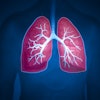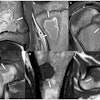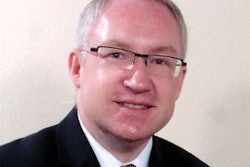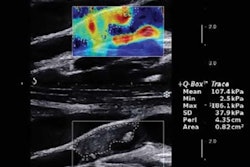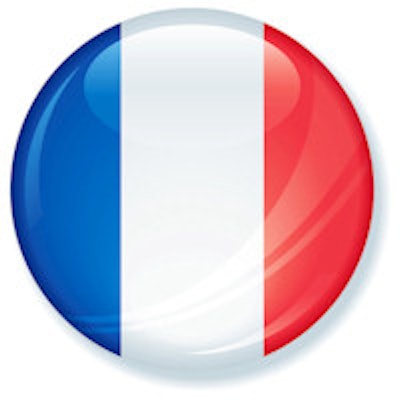
A research paper describing a new type of ultrasound that can produce ultrafast 3D videos has won its authors the 2014 Roberts Prize for the best paper published in Physics in Medicine & Biology last year. The winning paper -- 3D ultrafast ultrasound imaging in vivo (Phys. Med. Biol., 2014 Oct 7, Vol. 59:19, pp. L1-L13) -- was written by researchers from the Institut Langevin, ESPCI ParisTech, CNRS, and INSERM in France.
Building on their previous work on 2D ultrahigh-frame-rate ultrasound, the researchers developed the 3D approach based on the emission of diverging or plane waves from a sparse virtual array located behind the probe. They designed a 1,024-channel ultrasound system to drive a 32 x 32 matrix array probe, and used graphics processing units to speed the processing of the backscattered signals.
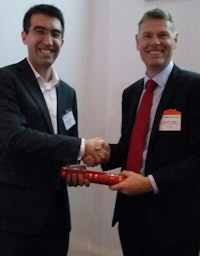 Author Jean Provost receives the Roberts Prize from IPEM President David Brettle.
Author Jean Provost receives the Roberts Prize from IPEM President David Brettle."One of the key developments was to achieve volumetric ultrasound imaging at a very high frame rate using a very simple approach," Mathieu Pernot, PhD, explained. "Volumetric imaging at high frame rate is currently not possible with conventional approaches. In contrast, with our method, frame rates of up to 5,000 images/sec can be achieved, which makes it possible to image blood flow in 3D or image the 3D propagation of shear waves."
In the winning research paper, Pernot and co-authors -- Jean Provost, Clement Papadacci, Juan Esteban Arango, Marion Imbault, Mathias Fink, Jean-Luc Gennisson, and Mickael Tanter -- demonstrated the use of 3D ultrafast ultrasound for several potential applications. These included 3D mapping of stiffness and tissue motion, as well as real-time imaging of blood flowing through the chambers of a human heart (see also 3D ultrasound goes ultrafast).
The paper represented a first important step in developing the foundations of a new ultrasound imaging modality, Pernot said. The next step, and one that the team is now actively working on, will be to develop clinical and preclinical applications of 3D ultrafast imaging, such as shear wave elastography, ultrafast Doppler imaging, and functional imaging of the brain.
"3D ultrafast imaging is a big step forward towards the development of novel applications," he explained. "For example, it enables real-time imaging of the full vasculature with high sensitivity. We envision that in the future, 3D ultrafast imaging will provide a more effective, more rapid, and operator-independent, diagnostic tool."
Pernot said he and his co-authors are delighted to receive the Roberts prize. "This is a great honor for us as it is not only a recognition of our own research, but it also recognizes the importance of today's research in ultrasound imaging," he told medicalphysicsweb.
The shortlist
The Roberts Prize is a joint award from IOP Publishing, the publishers of PMB, and the journal owners, the Institute of Physics and Engineering in Medicine (IPEM). The winner is chosen via a two-stage process. First, a shortlist of contenders is drawn up based on those papers that had the best referees' quality assessments, with a further quality check and endorsement by the editorial board. The shortlisted papers are then assessed by members of the journal's international advisory board, who rank them in order. After a quorum of members has voted, the paper that scores the most points is declared the winner.
The following articles (listed in alphabetical order) were shortlisted for the 2014 Roberts Prize:
Maryam Moteabbed et al The risk of radiation-induced second cancers in the high to medium dose region: A comparison between passive and scanned proton therapy, IMRT and VMAT for pediatric patients with brain tumors Phys. Med. Biol. Vol. 59, pp. 2883.
Tam Nhan et al Modeling localized delivery of Doxorubicin to the brain following focused ultrasound enhanced blood-brain barrier permeability Phys. Med. Biol. 59, 5987.
Jean Provost et al 3D ultrafast ultrasound imaging in vivo Phys. Med. Biol. Vol. 59, pp. L1.
Joost M Verburg and Joao Seco Proton range verification through prompt gamma-ray spectroscopy Phys. Med. Biol. Vol. 59, pp. 7089.
Siavash Yousefi and Ruikang K Wang Simultaneous estimation of bidirectional particle flow and relative flux using MUSIC-OCT: phantom studies Phys. Med. Biol. Vol. 59, pp. 6693.
© IOP Publishing Limited. Republished with permission from medicalphysicsweb, a community website covering fundamental research and emerging technologies in medical imaging and radiation therapy.

